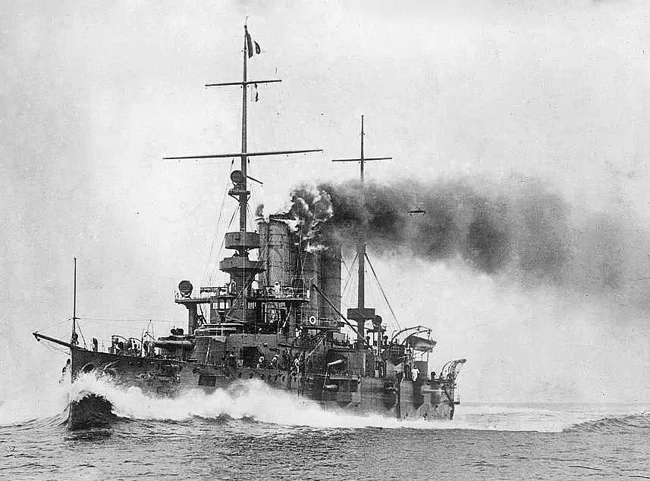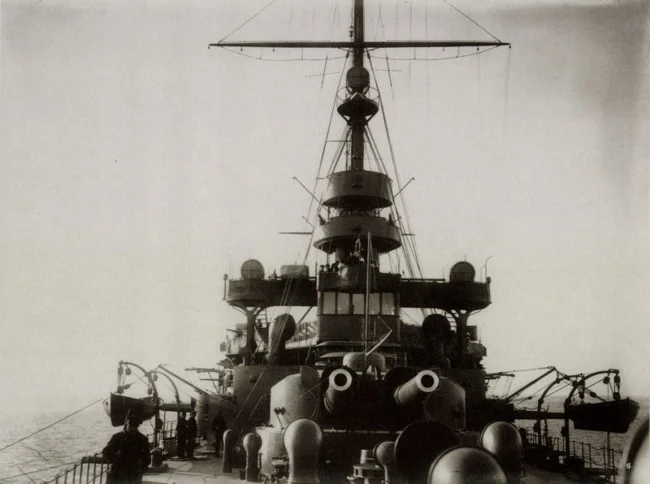Compact, maneuverable, protected, and... useless. Erzherzog Karl-class battleships (5 photos)
At the beginning of the 20th century, the Austro-Hungarian Empire was actively expanding its navy, seeking to at least partially close the gap with its hypothetical adversaries—Italy and France. A major step forward in this direction was the commissioning of the Erzherzog Karl-class battleships. They were compact, maneuverable, well-protected, and… useless. 
Battleship Erzherzog Ferdinand Max underway
In 1899, the Habsburg-class battleship project was developed and launched. By sacrificing endurance and range for speed and protection (which was justified in the Adriatic), the Austrians created ships capable of engaging and winning a battle against an enemy of equal strength, or escaping if the enemy had superiority. However, the Habsburg class was more of an armored cruiser than a squadron battleship.
Thus, in 1901, development of a design with reinforced armor began. Due to a lack of funds, the ships were again to be small, but built entirely from domestic materials and in domestic shipyards. The Reichstag soon approved the program, and in 1902, the first two units of the Erzherzog Karl class were laid down.
The ships had the following specifications: length 126.2 meters, beam 21.8 meters, draft 7.5 meters, displacement 10,640 tons. The 18,000 hp propulsion plant consisted of two four-cylinder vertical triple-expansion steam engines driving two propellers. The designed speed was 19.3 knots, but during trials, all three battleships exceeded this, reaching 20-20.5 knots.
The armor was made of case-hardened Krupp steel. Its thickness in the main belt was 210 mm, tapering to 152 mm toward the ends. The single armored deck was covered with 55 mm thick plates. The turrets and casemates had armor thicknesses of 240 mm and 150 mm, respectively. The ships' conning towers had armor thickness of 220 mm, and the bulkheads inside the battleships separating the various compartments were 200 mm thick. 
View of the superstructure of the battleship Erzherzog Karl, 1908
The armament consisted of four 240 mm main guns, arranged in two turrets at the ends. The guns were copies of the German Krupp guns, but were manufactured at the Škoda factories. They were lightened, which reduced their penetrating power, but increased their rate of fire to 3-4 rounds per minute. According to Austrian calculations, this combination of characteristics would allow for effective combat with Italian cruisers, which were considered the primary adversaries of the Erzherzog Karl class.
The 240 mm guns were complemented by extremely powerful secondary armament. Twelve 190 mm guns were mounted on each side: four guns on each side were mounted in casemates on the main deck, and two more were in single-gun turrets on the upper deck. There were 12 x 1 66 mm/45 guns on the superstructure and 4 x 1 47 mm/44 guns on the masts. Furthermore, the battleships were among the first in the world to receive anti-aircraft armament during construction: 4 x 1 37 mm Vickers guns, which was later reinforced by two 66 mm Škoda guns. Two 450 mm underwater torpedo tubes were also carried.
All three battleships were built at the private shipyard Stabilimento Tecnico Triestino in Trieste. Erzherzog Karl was laid down on July 24, 1902, and commissioned on June 17, 1906. Erzherzog Friedrich was laid down on October 4, 1902, and commissioned on January 31, 1907. Erzherzog Ferdinand Max was not laid down until March 9, 1904, but thanks to accelerated construction, she was commissioned on December 21, 1907, not too late.
At the beginning of World War I, all three battleships were part of the 3rd Division, with units of which they were mobilized and sent to support the German cruisers SMS Goeben and SMS Breslau, which were breaking through to Turkey. The Germans managed to break away from the Entente forces on their own, so the Austrians, already near Brindisi, turned back. 
Erzherzog Karl, Erzherzog Friedrich, and Erzherzog Ferdinand Max in the port of Barcelona, March 15, 1908
The next major action did not occur until May 1915. The Austrian fleet attacked Ancona. During the bombardment, Erzherzog Karl, Erzherzog Friedrich, and Erzherzog Ferdinand Max destroyed the city's infrastructure and suppressed the Italian coastal artillery.
After this, the naval war effectively ended for capital ships. The blockade of Otranto by a powerful Entente naval force prevented the Austrians from conducting any operations. The few that did take place were mostly limited to light cruisers, destroyers, and submarines. Therefore, when the crews of the armored cruisers moored at Catarro mutinied on February 1, 1918, three idle Erzherzog Karl-class battleships were deployed to suppress them. Once the mutiny was suppressed, the two cruisers whose crews had "distinguished themselves" were decommissioned, and their place on patrol was taken by the newly arrived trio of battleships.
After this, Erzherzog Karl was briefly involved in the Austrian operation at Durazzo, but did not make contact with the enemy. Meanwhile, the new commander of the Austro-Hungarian Navy, Admiral Miklós Horthy, prepared a plan to break the Otranto blockade, according to which the Erzherzog Karl-class battleships were to destroy the trapped enemy on June 11, 1918. However, after the sinking of the battleship Szent István, the operation was canceled, and the large surface ships remained idle in ports for the remainder of the war. 
Capitulation of the Austro-Hungarian fleet at Cattaro. In the foreground is the battleship Erzherzog Karl, with the light cruiser Novara visible behind.
With the collapse of Austria-Hungary, all Erzherzog Karl-class battleships fell under the control of the newly formed state of Yugoslavia. However, they were soon handed over as reparations. Erzherzog Ferdinand Max was acquired by Great Britain in 1920, and the following year, the battleship was scrapped. The same fate befell Erzherzog Friedrich, which was transferred to France. The lead ship, Erzherzog Karl, was also intended for the French, but while being transferred to Toulon, she ran aground in Bizerte, where she was dismantled.
It is easy to see that the Erzherzog Karl-class battleships saw little combat service, even against the backdrop of the general inertia of the Austrians. Possessing excellent characteristics, they could compete on equal terms with the Italians—they were the main contingent of the blockade force at Otranto. But the command's fear of defeat and the loss of its fleet cost the empire the chance to reverse the situation, and the Erzherzog Karl-class a chance to prove itself in action.






























